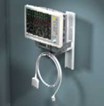Software helps speed design of Siemens patient monitors

Medical product designers know all too well about the pressures of shortening a new product's time to market. A computer-aided design (CAD) program is one thing that can make a significant difference. The right program can shave months off the project's life cycle and can even eliminate some common headaches along the way.
The Electromedical Division (EM) of Siemens Medical Systems Inc. discovered this when it began designing its Infinity Patient Monitoring System. The Infinity system monitors dual-chest-lead ECG, SpO2, respiration, dual temperature, dual invasive blood pressure, noninvasive blood pressure, and arrhythmia.

The Infinity system comprises a series of modular and configured monitors designed to give hospitals "infinite" functionality in monitoring patients. Using the patented Siemens Pick and Go technology, Infinity monitors such as the SC 9000XL move with a patient throughout the hospital, providing continuous patient data collection. When a patient is in transit, the monitor operates through an internal, rechargeable battery. When the monitor is placed on the Infinity Docking Station, power and network connections are immediately restored while the battery is recharging.
Escaping the wireframe fog
Siemens engineers realized they needed an intuitive, easy-to-use CAD system to streamline the design cycle for this advanced patient monitoring system.
"We were getting more and more frustrated with the CAD software we were using," explains senior mechanical engineer Per O. Hoel. "We needed a solution that would allow us to do solids and surfaces in a unified environment and better visualize what we were trying to accomplish."
Adds Hoel, "The software we were using was driving the operators, expecting them to jump through so many hoops and be cognizant of so many workarounds that focusing on the job was taking a back seat to managing the software."
Specifically, engineers needed to reduce prototype costs and tooling modifications—both of which save time and money—by gaining a better, more detailed, on-screen understanding of components and assemblies. After evaluating several different systems, Siemens selected the SolidWorks CAD system from SolidWorks Corp. and immediately deployed the software on the design of the new patient monitoring system.
The freedom to stylize components
"The reliable data translation tools in SolidWorks have simplified the conversion of many of our existing CAD-based parts for use in new assemblies," says Hoel. "SolidWorks was developed from the ground up with the Windows user interface in mind, which makes it easy for anyone familiar with Windows and part design to jump right in and make some real headway."
With SolidWorks installed, Siemens engineers not only achieved their objective of streamlining the design cycle but also discovered that SolidWorks ease-of-use gave them more freedom to experiment with, refine, and stylize components.
For example, the Infinity Docking Station and SC 9000XL monitor system include a junction box that connects sensor cables from the patient with the system's internal electronics. "If not for SolidWorks, that junction box could have been pretty blocky," Hoel says. "But because of the ease of organically modeling in SolidWorks, we came up with something much more elegant."
Reducing component design time by 25%
By deploying SolidWorks, the company met its goal of bringing the the Infinity Docking Station and SC 9000XL monitor to market faster. "We've seen a 25% time improvement in the design of individual components," Hoel says. "But the real advantage is the reduced prototype costs we've had because so much more can be done virtually. Interference checking capability has given us the power to avoid unforeseen tooling modifications, thus shortening lead times and lowering total expense."
Hoel points out that before implementing SolidWorks, an engineering change request could require an extraordinary amount of CAD work. "With SolidWorks, changes don't bother us anymore. Because it's so easy, we've started taking its capabilities for granted and what used to be extraordinarily time-consuming and tedious can now even be fun to deal with."
For more information, contact:
SolidWorks Corp., 300 Baker Ave., Concord, MA 01742; Tel: 800-693-9000; Fax: 978-371-5088; e-mail: info@solidworks.com. Or visit the company's storefront on Medical Design Online.
Siemens Medical Systems Inc., 16 Electronics Ave., Danvers, MA 01923; Tel: 800-333-8646; Fax: 978-774-8342; www.sms.siemens.com.
